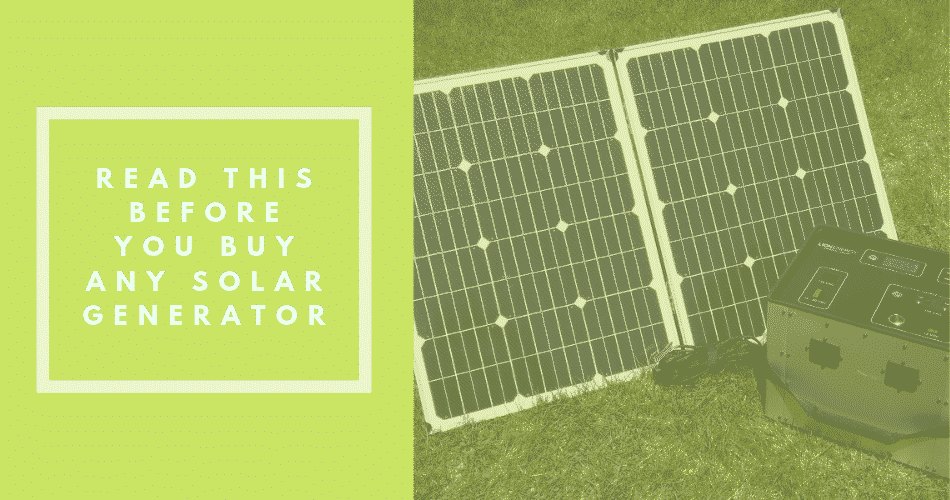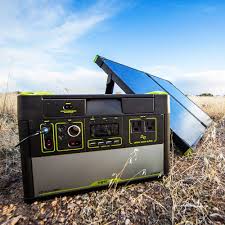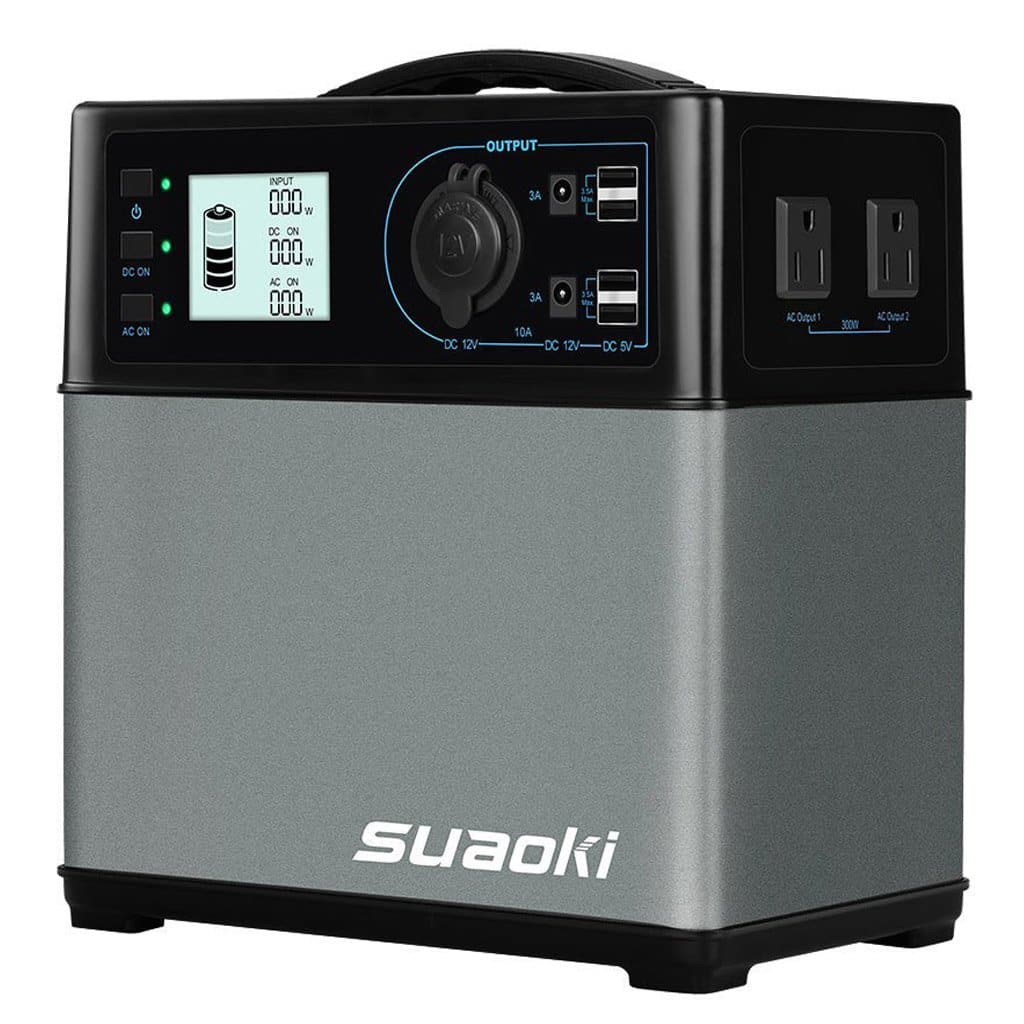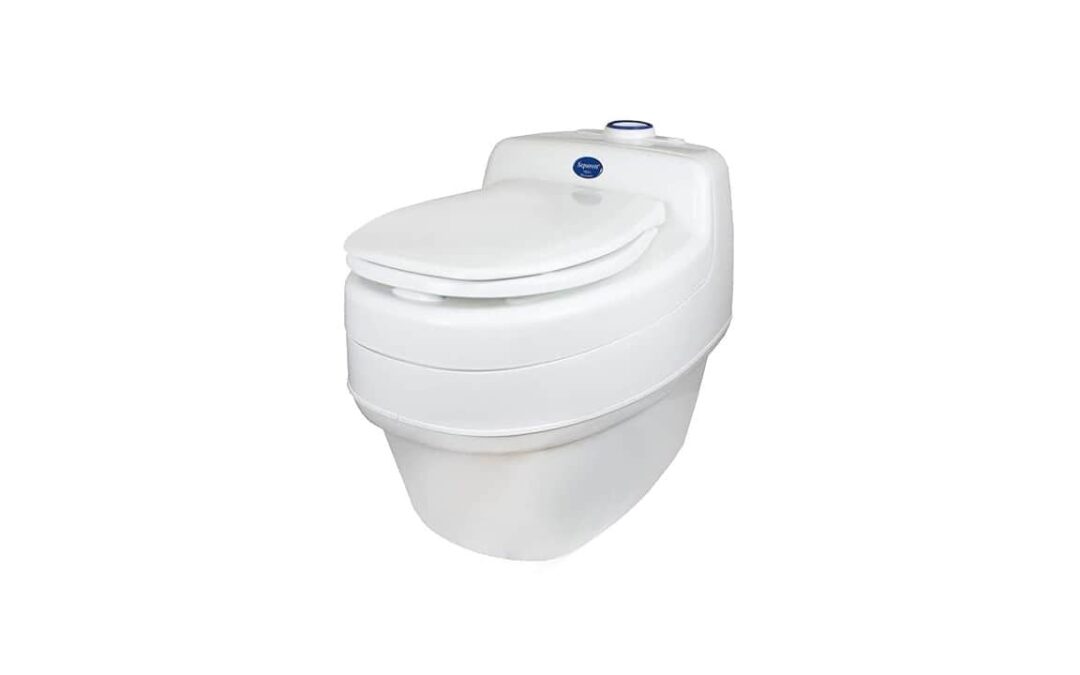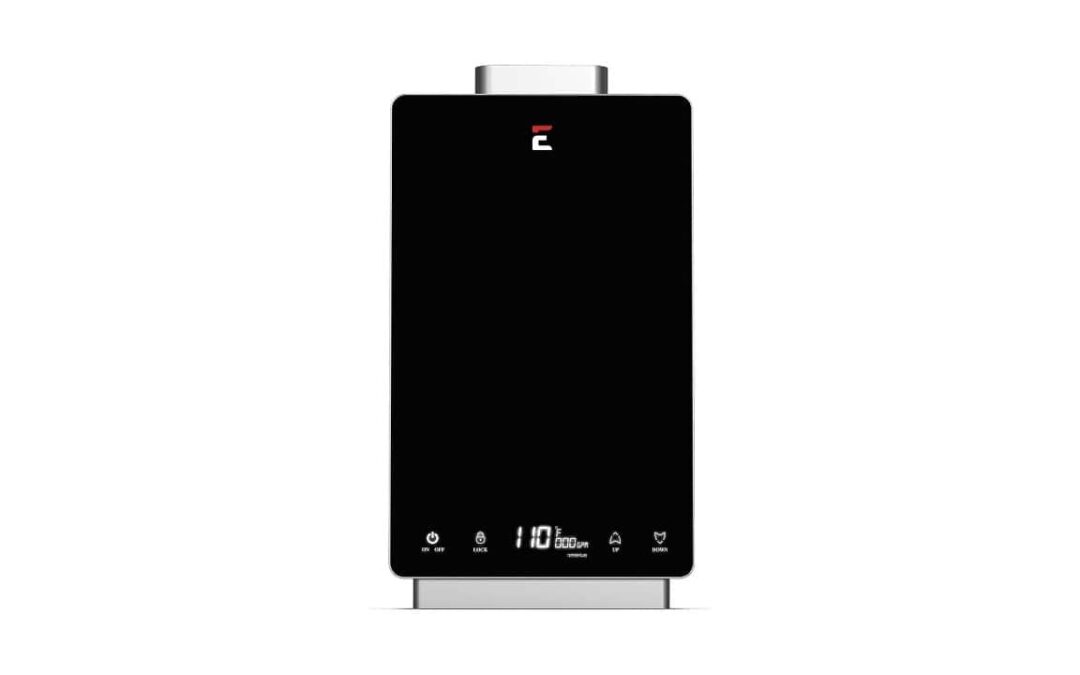“How can I power my tiny house when I’m not connected?”
This is one of the most important, and most common, questions to ask as a tiny house dweller.
Whether you’re living in a THOW (Tiny House On Wheels), off the grid, or simply want to live sustainably in the city, using solar power can be an excellent way to power your home.
Advances in solar power have made panels more affordable than ever, but that still leaves you with the question of what to do with that power.
And since putting together a solar battery bank can be a little intimidating (especially if you aren’t already a DIY kind of person), using a commercial solar power generator can be a great option for setting up your solar system.
In this article, we’ll be reviewing some of the best solar power generators on the market to help you find the one that best fits your needs.
For those who want a quick overview, below is our comparison table:
- Our #1 Best Solar Power Generator: Goal Zero Yeti 1400
- Our #2 Runner Up Best Solar Power Generator: Renogy Lycan Powerbox
- Our #3 Best Budget Option: Nature’s Generator
- Our #4 Best for Small Appliances: EF EcoFlow River(Best For Charging Your Phone While Camping)
Best Solar Power Generator Of 2024: Goal Zero Yeti 1400
The Yeti 1400 Lithium power station is another Goal Zero product optimized to work with their portable solar panels. It uses a 1425Wh lithium ion battery and is equipped with the latest control and connectivity equipment.
It includes a 1500W pure sine wave inverter capable of an initial surge of 3000W. This makes it suitable for powering major appliances, like refrigerators for 23+ hours. It can be charged through AC or DC power or using up to 360W of solar panels.
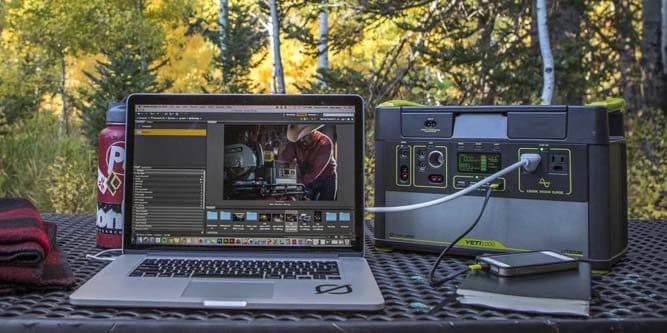
Like other large Goal Zero solar generators, you can chain the Yeti 1400 to additional batteries. This lets you increase the size of your solar battery bank without purchasing more charge controllers or inverters.
One really useful feature involves the Goal Zero monitoring and control app.
It allows you to wirelessly connect your Yeti 1400 to your home network and monitor it remotely. You can check the battery level, discharge rate, and lots of other useful figures from anywhere.

Because it runs on a lithium ion battery, it’s lighter than many solar generators with similar capacity. It weighs just 43.7 pounds and can be moved easily with the dual handles on top.
It offers numerous output options, including:
- One USB-C port
- One USB-A port
- One USB-PD port
- 6mm DC port
- 12V car port
- 12V Power Pole Port
- Two universal AC ports
Pros
- Lithium ion battery is dependable and lightweight
- Chainable with additional batteries
- Charges quickly from up to 360W of solar panels
- Provides up to 3000W surge inverter power
- Easy to read LED status window
- Can be monitored remotely using Goal Zero’s app
Cons
- Lithium ion battery increases cos
Runner Up Best Solar Power Generator: Renogy Lycan Powerbox
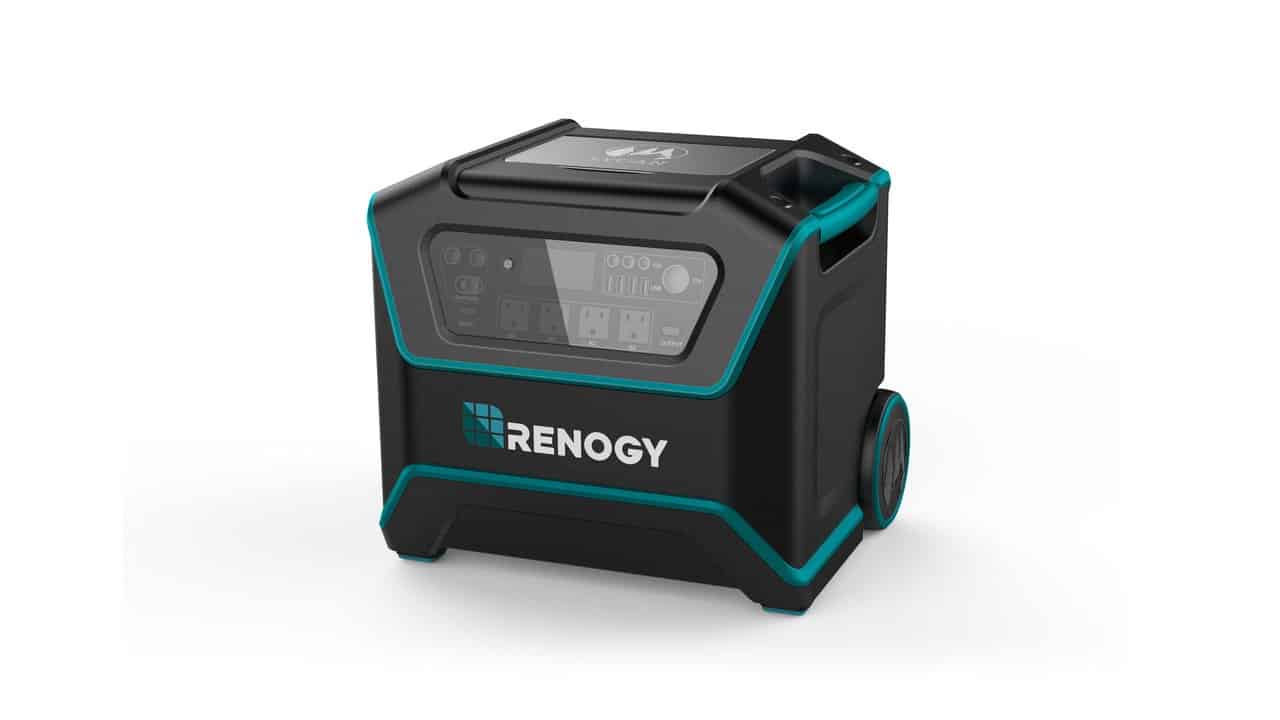
- Provides enough power for medium to large appliances
- Can be charged with AC/DC power or through solar panels
- Lithium battery offers 2000+ charging cycles
- Easy to read LED status screen
- Accepts 300W of solar panel charge
- Allows battery exchange
- Relatively Lightweight
- Get 10% Off With Promo Code: TLL10
Renogy is one of the biggest names in tiny home solar. They offer a variety of useful products, including solar panels, charge controllers, and solar generators.
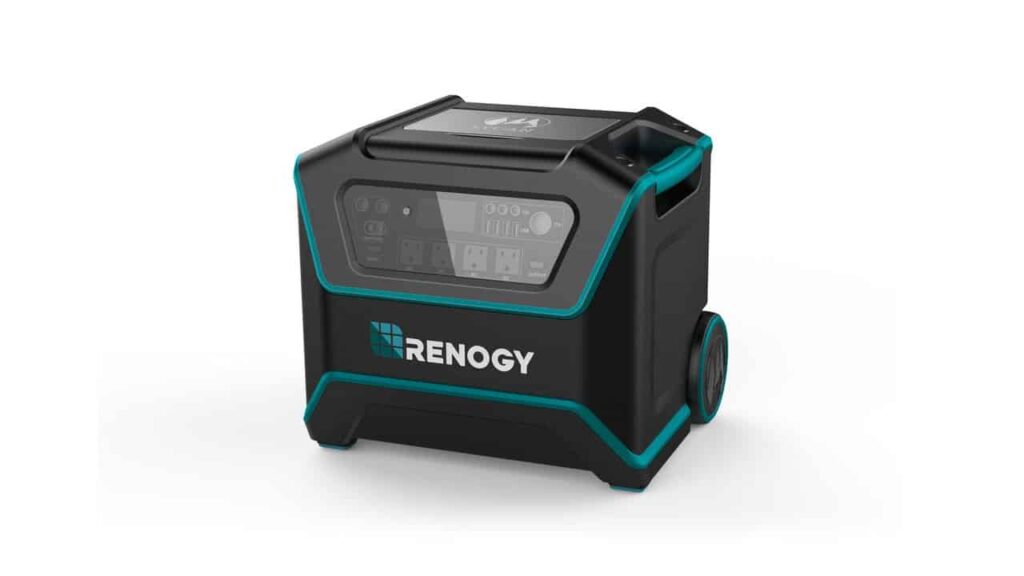
The Lycan Powerbox is a 1075Wh solar generator powered by a lithium-iron-phosphate battery.
This gives you improved storage and energy density over AGM batteries, but does noticeably increase the price.
It can be charged using solar panels, wall AC power or with a DC plug, similar to those found in a car.
It uses a 1200W pure sine wave inverter, allowing it to power everything from small electronics to large appliances, like refrigerators.
It’s capable of accepting charge from up to 300W of solar panels, which is excellent for a solar generator of its size.
One great feature of the Renogy Lycan Powerbox is its ability to rapidly switch out the internal battery.
Why is this helpful?
Because it allows you to charge up one battery, then switch it out with a second—giving you double the battery capacity at a very reasonable price.
And despite its large battery capacity, it weighs just 63 lbs.
It’s mounted on a pair of wheels and has a collapsible handle to make moving it around easy.
It offers a total of 12 output ports, including:
- Four AC ports
- Four 5V/2.4A USB ports
- One 12V DC car outlet
- Three 12V DC ports
And even better, for a limited time, Renogy is offering 10% off when you enter this promo code at checkout: TLL10

Pros
- Relatively lightweight
- Provides enough power for medium to large appliances
- Can be charged with AC/DC power or through solar panels
- Lithium battery offers 2000+ charging cycles
- Easy to read LED status screen
- Accepts 300W of solar panel charge
- Allows battery exchange
Cons
- Expensive for capacity
Best Budget Option For Overall Solar Power Generator: Nature’s Generator – 1800W Solar & Wind
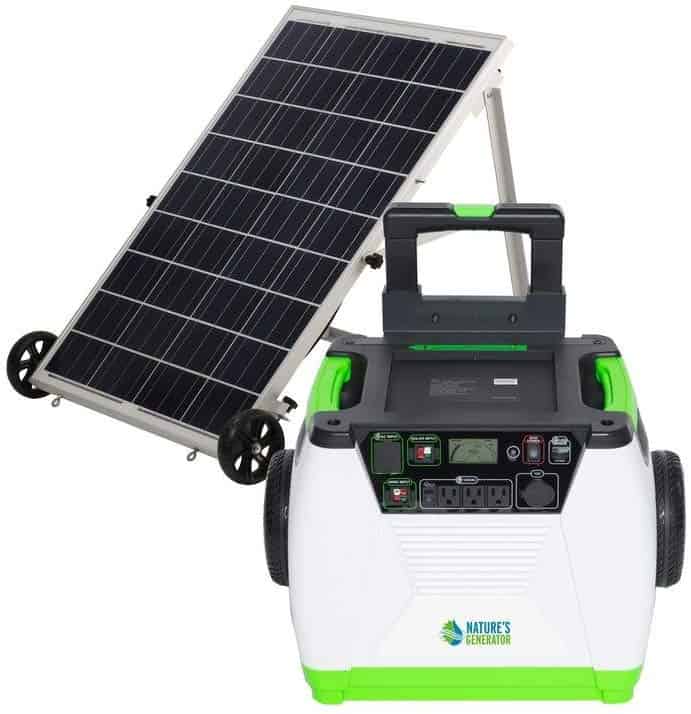
- Affordable high capacity solar generator
- Offers a variety of ports and charging options
- Provides 8 – 12 hours on a single charge
- Can be combined with Nature’s Generator Wind Turbine for wind power
- The solar panel can be daisy-chained using our MC4 Branch connector
Our top choice for the best budget option for all your charging needs is the Nature’s Generator. It offers enough capacity to power medium to large appliances while still being portable enough for outdoor use.
It’s a 720Wh portable solar generator designed to work with a variety of Nature’s Generator and similar solar panels. It has a 60Ah AGM battery, capable of providing power to large appliances like refrigerators for 8 to 12 hours on a single charge.
It can be charged from a wall outlet, with solar panels, through home wind turbines or by connecting it to your car DC port. It will fully charge from a 200W solar panel in just 12-24 hours depending on sun exposure.
It includes an 1800W pure sine wave inverter capable of fully drawing out the battery’s power. This inverter offers a surge capacity to help start up larger appliances.
The package also includes a portable 100W polycrystalline solar panel. This gives you a jumpstart for your overall solar system.
One really useful feature of the Nature’s Generator is its ability to chain charge the company’s Nature’s Power Pods. These are 100 Ah battery packs designed to instantly connect to your Nature’s Generator through a fused 200A expansion port on the back.
It offers multiple charging ports, including:
- Two USB ports
- Three 120V household AC outlets
- One 12V DC car port
- Expansion Port with 200A Fuse
- AC Input port
- Solar Input Port
- Wind Input Port
Pros
- Affordable high capacity solar generator
- Offers a variety of ports and charging options
- Provides 8 – 12 hours on a single charge
- Can be combined with Nature’s Generator Wind Turbine for wind power
- The solar panel can be daisy-chained using our MC4 Branch connector
Cons
- Although the roll cart is great, it’s still very heavy at 90 lbs
- Battery requires a maintenance charge for effective storage, with a required top up at least every 2 to 3 months
Best Pick For Budget and Small Scale Solar Generator: Ef Ecoflow River Portable Power Station
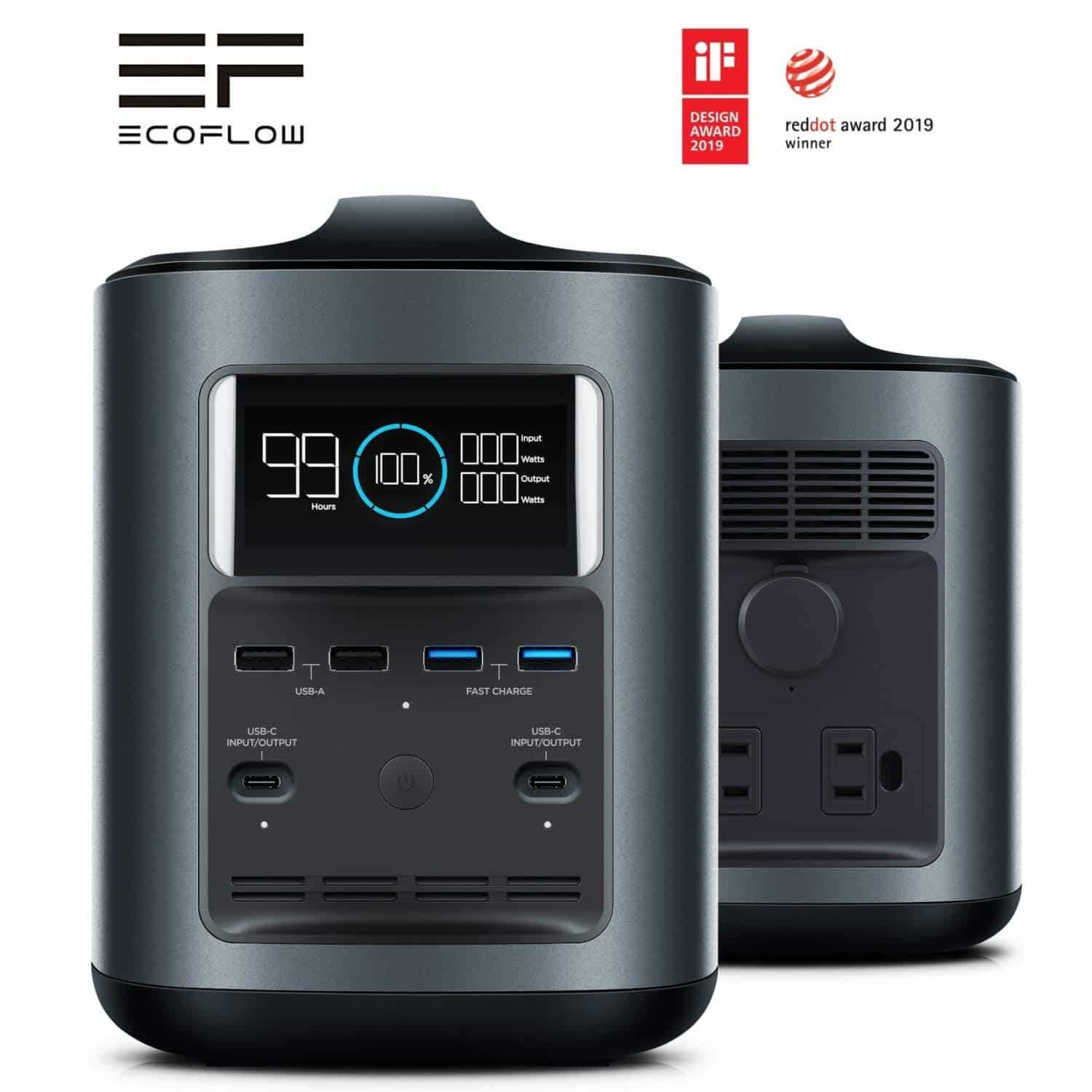
- Provides enough power for medium to large appliances
- Can be charged with AC/DC power or through solar panels
- Lithium battery offers 2000+ charging cycles
- Easy to read LED status screen
- Accepts 300W of solar panel charge
- Allows battery exchange
- Relatively Lightweight
The EF EcoFlow River is a 412Wh portable solar generator designed to be a flexible power option anywhere you find yourself. It weighs 11.3 lbs and is powered by a lithium ion battery.
It uses a 300W pure sine wave inverter capable of producing 500W of surge power. This is suitable for powering small electronics and appliances like a mini fridge. However, it’s not enough to run a full-size refrigerator or anything that requires a heating element.
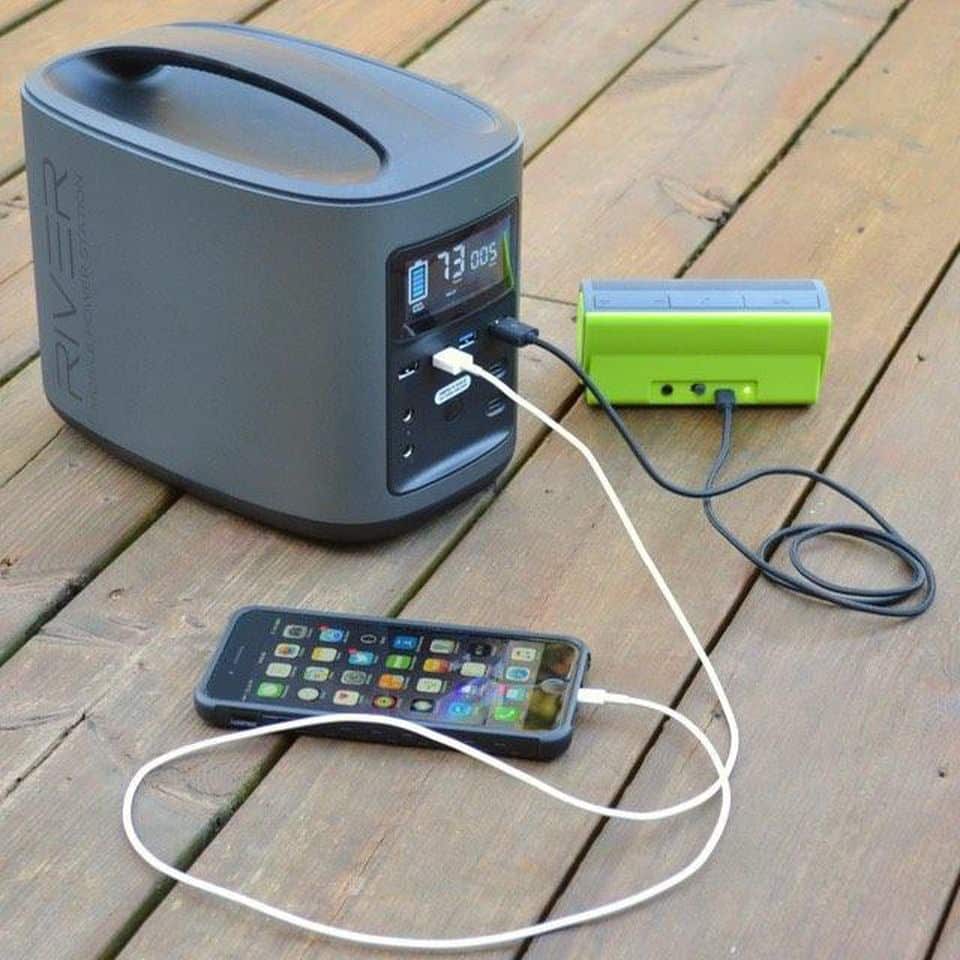
You can charge up the River using AC power, a car DC adaptor or with solar panels. One of the things that helps set the River apart from its competitors is how ruggedly designed it is.
It’s capable of operating efficiently in temperatures ranging from -4 to 140 ℉. This makes it perfect for backcountry use or when taking your tiny home to places like Alaska.
EF EcoFlow also optimized its charge maintenance settings to allow for a long storage shelf life. It can go for up to a year between charges without creating maintenance issues.
It offers several different charging ports, including:
- Two USB-C ports
- Two AC ports
- Two 6mm DC ports
- Two USB Type-C ports
- Two USB QC 2.0 ports
- One 12V DC car port
Pros
- Affordably priced
- Advanced battery maintenance software
- Diverse charging options
- Withstands considerable temperature extremes
Cons
- Not powerful enough to power full-size appliances
- Can’t be chained to additional batteries
Runner Up Budget and Small Scale Solar Power Generator: Suaoki 400Wh
The Suaoki 400Wh portable solar generator is a lightweight and low cost system designed for emergency and outdoor use. It runs off a lithium ion battery and uses a pure sine wave inverter with a continuous capacity of 300W.
This makes it perfect for charging up small electronics, like smartphones, laptops, GPS systems, etc, but doesn’t allow it to power larger appliances.
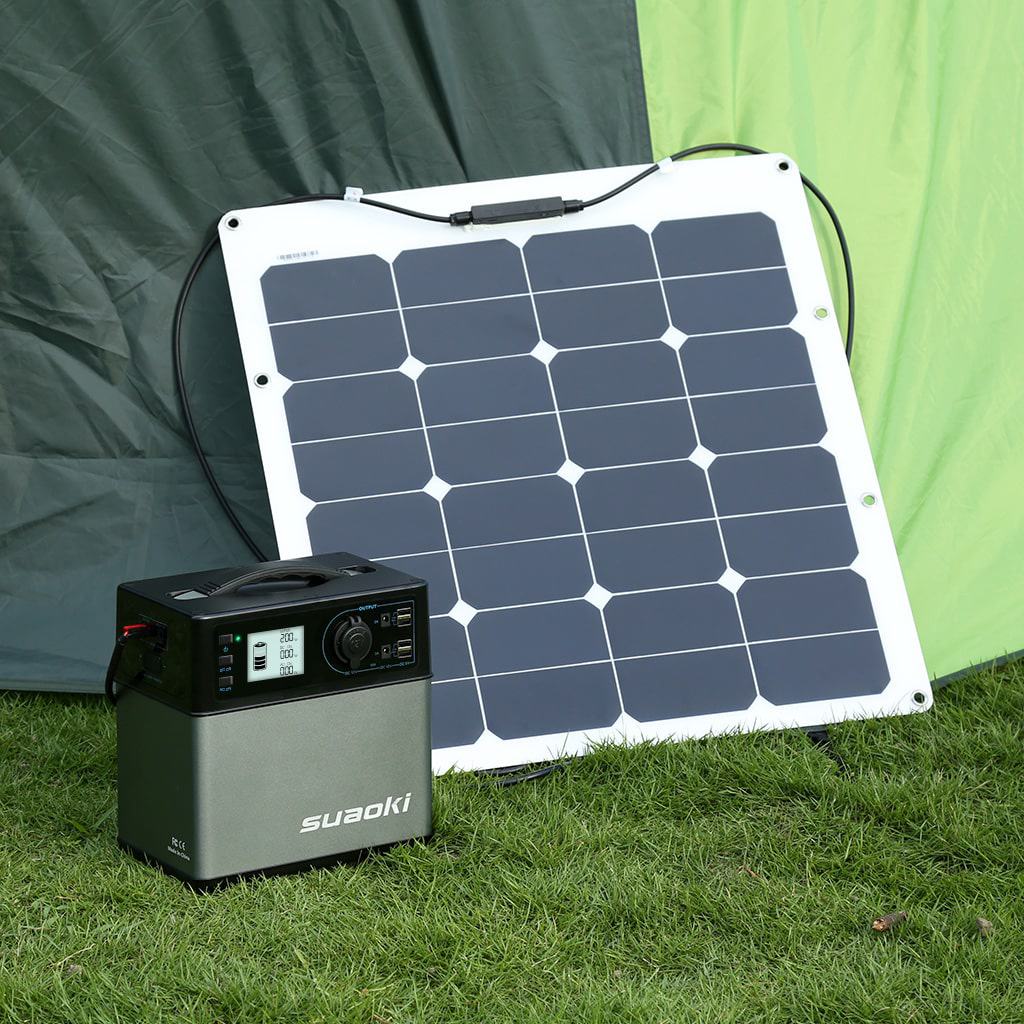
It’s capable of charging from AC wall power, DC car power or with up to 10W of solar panels.
At just 12.5 lbs it’s definitely on the small side for a solar generator, but it’s great if you just want to run the basics.
For people looking for the lowest cost power solution for their tiny home, this is a great option.
It has a variety of ports to aid in charging, including:
- Two AC outlets
- Two DC outlets
- Four USB outlets
- Two car style DC outlets
Pros
- Affordable
- Extremely portable and lightweight
- Able to charge most small electronics
Cons
- Very low solar charging capacity
- Unable to power larger electronics like appliances
- Battery capacity smaller than many similar solar generators
Best Solar Generator For Short Trips: Jackery 240WH Portable Power Station
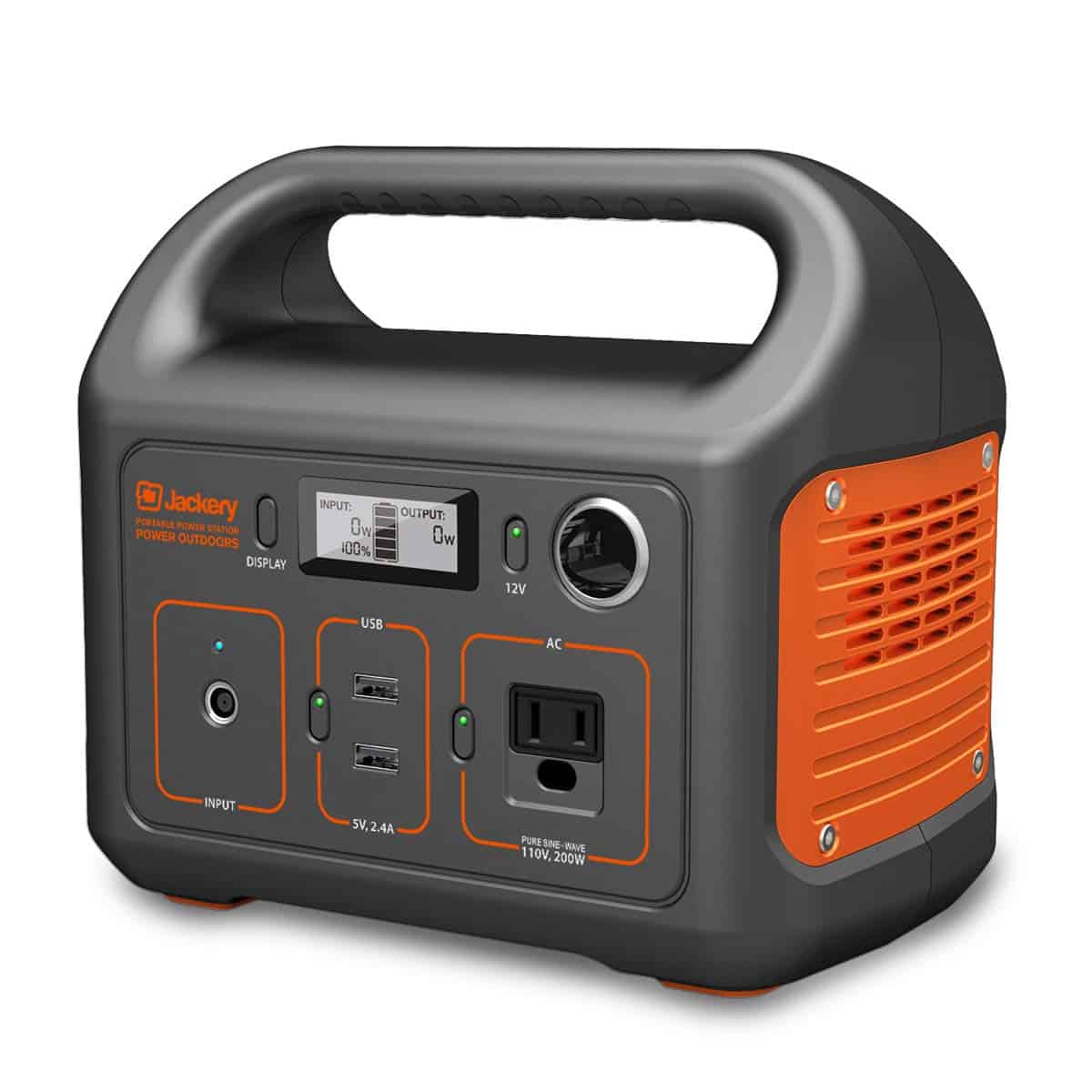
- Compact and lightweight
- Very affordably priced
- Capable of charging most small electronics
- Built-in LED flashlight
- Powerful enough to charge a smartphone 18 times, a laptop 4 times, a Gopro 40 times, Drone, Mini Projector, Mini-Refrigerator or other small power appliances
- Ideal for camping, RV, or emergencies
The Jackery Portable Power Station is a 240Wh solar generator. It weighs just 6.6lbs and is powered by a lithium ion battery for dependability and longevity.
It includes a 200W pure sine wave inverter with a surge capacity of 400W. This makes it suitable for charging small electronics but isn’t enough to keep appliances or larger devices running.
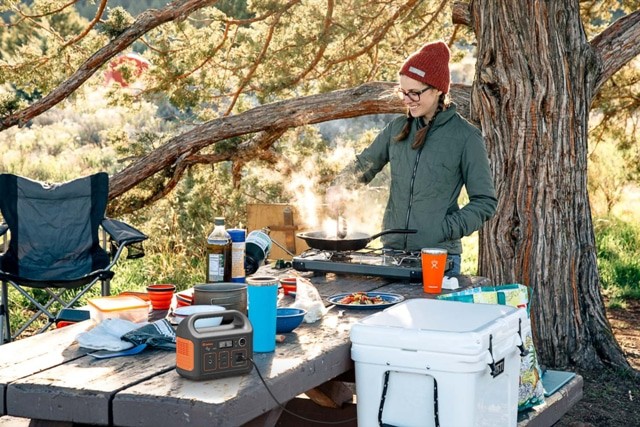
It offers three charging options: Through solar panels, with the included AC outlet charger, or through the 12v cigarette lighter socket. Each takes about 8-10 hours to fully charge up the battery. It can charge from solar panels up to 50W.
It offers a variety of ports, including:
- One AC outlet
- Two USB-A ports
- One DC car port
Pros
- Compact and lightweight
- Very affordably priced
- Capable of charging most small electronics
- Built-in LED flashlight
- Powerful enough to charge a smartphone 18 times, a laptop 4 times, a Gopro 40 times, Drone, Mini Projector, Mini-Refrigerator or other small power appliances
- Ideal for camping, RV, or emergencies
Cons
- Battery capacity too low to power medium and large appliances
- Can’t be chained with additional batteries
What is a Solar Power Generator?
A solar power generator is a combination charge controller, battery, and inverter all rolled into one. It lets you plug in solar panels and get a full fledged power station without any of the installation headaches usually required.
Instead of having to permanently wire solar panels to a charge controller and batteris, you can plug them into the solar generator whenever and wherever you like.
For people considering a tiny home, they’re one of the best ways to quickly and affordably get a small scale solar system set up.
How to Compare Solar Generators
When you’re trying to compare solar generators from different companies, there are a number of basic metrics to look at. These are:
- Battery Capacity
- Inverter Type
- Inverter Rating
- Portability
- Ease of Use
Battery Capacity
Probably the first thing you should look at when considering different solar generators is their battery capacity. Think about what you need to power and figure out if they’re capable of meeting your needs.
Battery capacity is measured in two main ways—Amp hours (Ah) and Watt hours (Wh).
Amp hours measure the actual current of a battery without regard for voltage.
Watt hours represent the flow of power over an hour’s time. To find Watt hours, multiply Amp hours by voltage.
A pretty bare bones system for off-grid living will be just large enough to power your phone and other small electronics.
Something around 400W will be sufficient for this task as long as you have enough solar panels to effectively charge it.
If you want to add in major appliances like a refrigerator things start to get bigger fast. You’ll need a minimum of 1000W to power most energy efficiency refrigerators for a 24 hour period.
If your battery capacity is only enough to power one appliance for a single day it probably won’t work long term. Solar generators that allow you to chain them to other batteries to increase capacity are a great way to get around this limitation affordably.
For most people around 1500W is going to be the minimum they need for powering basic appliances and small electronics sustainably.
Inverter Type and Rating
Two important factors to consider when comparing solar generators is the type of inverter it uses and what its rating is. The two main types of inverters are pure sine wave and modified sine wave.
At this point you should only consider a pure sine wave inverter. Modified sine wave inverters are cheaper, but the performance tradeoffs make them a losing proposition.
The inverter rating of a solar generator refers to how much power you can pull from the batteries at any time. If you’re just looking to charge your phone and other small electronics, you won’t need more than about 100-200 W.
When you’re comparing battery capacity and inverter rating, make sure they match up. You should have at least as much battery capacity as your inverter rating: 1.5X would be even better.
Portability and Ease of Use
When you’re talking about solar generators with enough capacity to run appliances, things get heavy fast.
Many solar generators will be over 50 lbs, with the largest ones weighing as much as 100 lbs.
If you’re planning to park your generator in a corner or on a shelf, this doesn’t really matter, but if you need to move it around, make sure you build it into your considerations.
Many of the larger solar generators are built with wheels and handles, and allows you to move them around a lot like a rolling suitcase.
You should also look at how easy it is to plug in and use your generator. Higher end models will have LED information screens and multiple ports in many different options.
Do The Math
The biggest factor when picking out a solar power generator is how much capacity you actually need. There are tons of great solar generators at the small, medium and large capacity levels.
If you want to get the best performance possible though for all of your power needs, the Goal Zero Yeti 1400 is the generator you should go with. It combines a lithium ion battery with the latest in connectivity features to power even the largest of appliances.
If you are looking for a great solar generator in the mid-level range, I love the the Nature’s Generator. It offers enough capacity to power most things you need and sits in the perfect sweet spot of price and capability.
For basic power needs at a very affordable price, the EF EcoFlow River is a great option. It offers highly advanced features in an easy-to-use package.
While it doesn’t have the capacity to power major appliances, it can handle your smartphone and other small electronics with ease.

